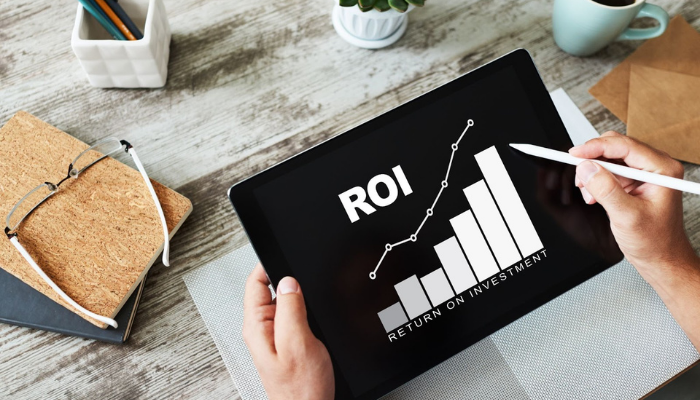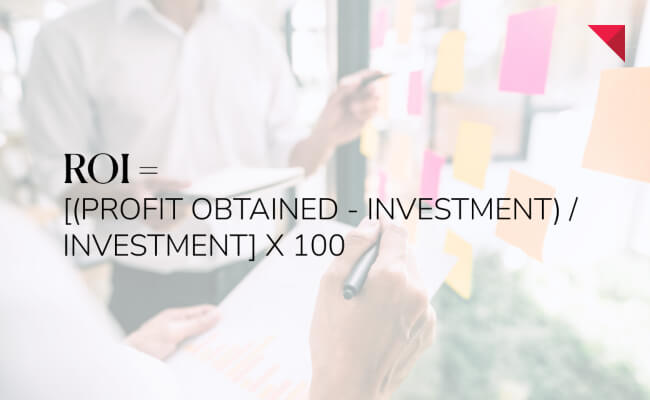What ROI is and why it’s so important for your company
Inbound Marketing is a safe bet for all kinds of companies. It’s a different approach to marketing that’s more in harmony with the digital world and has a methodology that puts the client and their needs in the center, instead of the product. Our main goals are the following: getting to know the target audience well, adapting our message to them, and convincing them to have confidence and interest in us.
The data speaks for itself. Here’s a few numbers collected by Invesp: businesses that apply Inbound strategies save more than $14 for each new client and a lead costs 61% less on average with this model if we compare it with an Outbound strategy. The ROI is also different: 41% of marketing experts say that Inbound ROI is measurable and 82% say that they have a positive ROI with Inbound Marketing.
But, what is ROI exactly? It’s one of the most common KPIs in Inbound Marketing and many people ask how ROI is calculated, how it’s analyzed, and what its role in all this is. The truth is that it’s very important to use this tool if you want to determine the profitability of your actions.

The meaning of ROI
ROI means Return on Investment, which means what you get from your investment. One of the biggest aspects of Inbound Marketing is the need to measure results; with the analysis of specialized tools like Tableau in Salesforce, we can evaluate the performance of our actions, identify our strengths and weaknesses, and make the right decisions with the information in our hands. Therefore, ROI is one of the variables we can’t ignore.
Thanks to ROI, you can determine the profits from your investment. It’s a necessary tool to evaluate the real situation of your marketing strategy and discover how it will influence the development of your business. With this information, you can measure the economic performance of the marketing actions you’ve already carried out and decide whether or not to continue with them.
How ROI is calculated in Inbound Marketing
To calculate ROI, there’s a predetermined formula:
ROI = [(PROFIT OBTAINED - INVESTMENT) / INVESTMENT] X 100
If we want to obtain a positive ROI, we have to reduce the acquisition cost of clients and increase the lifetime value of the client. The ABC of ROI Marketing, written by Gianluca Fiorelli, WAM’s SEO & Digital Strategy Consultant, gives ROI examples so you can visualize it; imagine that you invest 100€ in an Adwords campaign and when the campaign ends, you’ve made 250€. To calculate the ROI, the formula would be the following:
ROI = [(250 - 100) / 100] X 100 = 150

If you ask yourself how to get the ROI, it’s pretty easy. In this example, we have a good final result: we’ve obtained a 150% ROI. ROI also exists in Social Media with its own metrics and it’s very important within influencer marketing.
ROI is an objective and fundamental concept of which to work off. But on the Internet, there are many variables at play and it’s possible that we could launch campaigns where conversion isn’t our main goal. That’s why, in addition to ROI measurement, there’s another concept that shares the same initials but has a very different meaning: IOR.
IOR: Impact of Relationships
IOR means Impact of Relationships. In the “new” form of digital marketing, the return on investment also is determined by the relationships that the brand builds on social media. IOR is based on the “impact of relationships” and it’s an essential source of information for brands that need to analyze the evolution of the campaigns that are launched on different networks.
To calculate the IOR on social media, we have these formulas:
-
Investment = Time + People + Tools
-
Profit = Relationships + brand presence on social media
We are talking about impact, not importance. IOR is calculated based on the impact on relationships, not on the direct impact on sales. In IOR, variables are applied to each action and interaction between the brand, their content, and their followers. For the calculation, the following variables are collected: webpage traffic, follower participation on the social networks where the brand has a presence, and the brand influence and its content, authority, and relevance of said contents. It has a complementary effect to ROI, not against it, that allows us to evaluate campaigns where conversion isn’t the primary goal.
To sum it up, we’ve learned what ROI is in digital marketing. The goal of calculating ROI is getting an actual idea of what is going on so that you can maximize your profit. This indicator will vary depending on the goals of the campaign and the way of measuring the metrics. Have you thought about improving the ROI of your campaigns? Now that you know how to use the formula, get to work!
Subscribe to our newsletter and stay up to date with the latest digital trends.
Subscribe to our newsletter and stay up to date with the latest digital trends.
No thanks. My inbox is fine as it is.